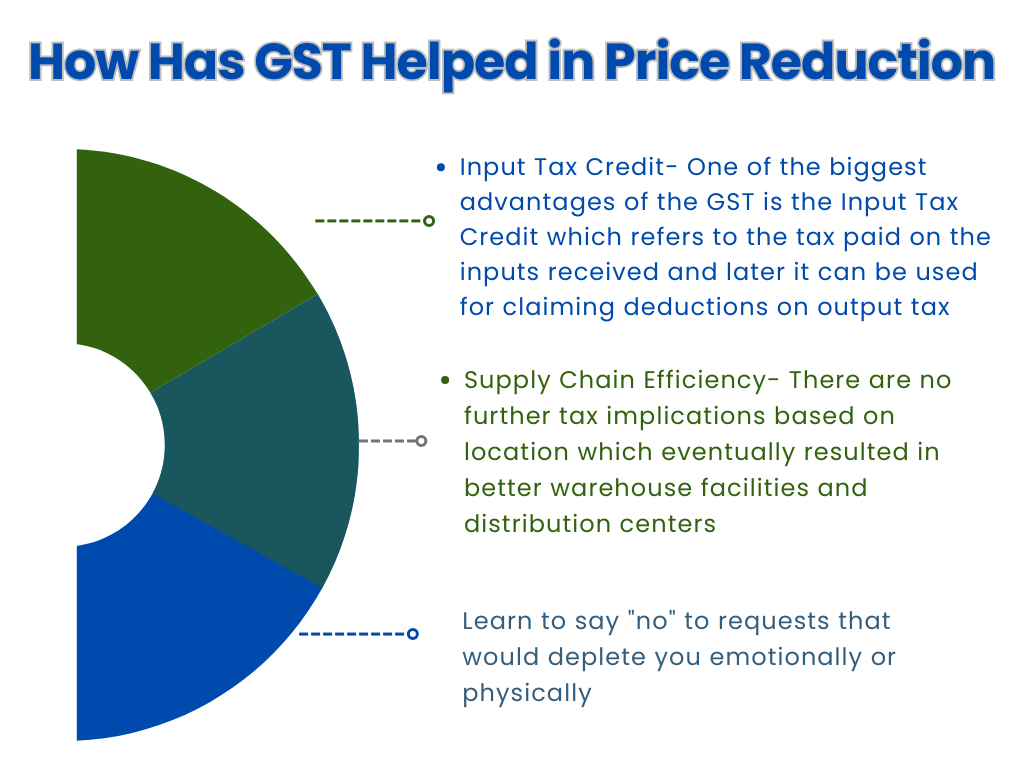How Has GST Helped in Price Reduction?
The Goods and Services Tax came into effect on the 1st of July 2017. Before GST was implemented in the county, the taxation system here was cascading and it negatively contributed to the increase in the cost of production and supplies. Now GST being a destination-based tax has contributed to price reduction in various ways. This article will discuss the Role of GST in Price Reduction for growing and established businesses.
Under the old tax regime, there were central taxes such as customs duty/central excise duty, central sales tax on commodities and services, surcharges, and cess. The state taxes in the previous regime were VAT, WCT, Entertainment, Luxury, etc. The GST has subsumed all these taxes and helped in unifying the taxation system of the country.
The following industries have witnessed price reductions after the implementation of the GST.
- Automobiles– small cars and two-wheelers have seen lower tax rates under the new tax regime resulting in price reductions for comparatively lower-income groups
- Transportation services– after the removal of state entry taxes and introduction of input tax credit, the transportation of goods and services has become more cost-effective encouraging inter-state trade
- Electronics– electronic items like home appliances, gadgets, mobile phones, and televisions have witnessed a sharp price reduction due to lower tax rates
- FMCG– rates have been slashed for fast-moving consumer goods for example soaps, hair oil, packaged products, toothpaste, detergents, washing powders, etc.
Benefits of the New Tax Regime in India
Uniformity of Registration- in the GST regime, the registration of any kind of entity or other is unified unlike earlier. Initially, the registration process was decentralized and both state and central authorities were involved in it but now with the help of PAN, all kinds of registration can proceed.
Destination-Based Tax- it is a destination-based tax means that the tax will be levied at the place of consumption, unlike VAT which was levied at the place where goods were manufactured or sold.
Ease of Filing Returns & Collection of Tax– now the dates of all GST Returns and other fillings are uniform all around the country making it more simplified for the regular taxpayer. However, in the old tax regime, the service tax and central excise were uniform but VAT altered from state to state.
Expanded Threshold Limits– the threshold limits of taxable turnover for businesses have increased under the new tax regime giving taxpayers more freedom to focus on growth and reducing the compliance burden.
Relief from Entry Tax– earlier certain states charged variable entry tax but now there is no entry tax applicable except a 1% additional tax on interstate supply of certain commodities
Digitalized Services– under the VAT system used to validate partly and fully verification was subject to assessment by state or central departments, however, under GST the validation of returns is done by the system itself bringing consistency and promoting transparency.

GST’s Role in Price Reduction for Businesses
Input Tax Credit
One of the biggest advantages of the GST is the Input Tax Credit which refers to the tax paid on the inputs received and later it can be used for claiming deductions on output tax. It benefits the taxpayers and protects businesses from the cascading effect of the taxes.
ITC helps in better management of cash flow for the business and gives the business a kick start. For example, you are a manufacturer and have a tax payable on output of Rs 1000 (output tax credit on sale). But when you made the purchase you paid an input tax credit of Rs 800 (input tax credit on purchase), now you can claim this input tax credit and deposit the rest of Rs 200 (Rs 1000- Rs 800) as taxes under the GST.
Earlier there was no such provision to claim ITC for the CST paid on the inter-state transactions leading to increased costs for the taxpayer.
Supply Chain Efficiency
The new GST regime has brought better changes in the supply chain. There are no further tax implications based on location which eventually resulted in better warehouse facilities and distribution centers. The producers have the freedom to incur fixed costs leading to lower prices for consumers. With better time management due to reduced transportation time and logistics costs, the delivery of services has become faster. Improved supply chain and logistics have cut the cost of production due to the elimination of previous taxation. Not only the end consumer but the manufacturer is reaping the benefits of this efficiency, faster delivery, and reduced cost of transportation and logistics.
Reduced Compliance Cost
Under the GST, the compliance cost for small or medium-sized businesses is slightly higher than those for large businesses. However, the larger business entities reap comparatively lower compliance costs even from the inception. Though experts still argue that the compliance cost under GST for small businesses is regressive, it turns out to be a progressive step for bigger businesses.
Conclusion
The GST not only benefited the taxpayer with the reduction in prices but also benefited them by bringing uniformity into the Indian taxation system, making taxation simpler and understandable to the common taxpayer. The Input Tax Credit mechanism under the GST is a coming-of-age solution for businesses to manage better cash flow. The digitalized practices and unified tax regime under the GST significantly reduced the cost of logistics.
The GST Tax Rates are designed in such a way that essentials are not taxed while luxury items are taxed based on usability. One centralized tax gave big relief from VAT, Central Excise Duty, and Central Sales tax.
For availing the services with TaxDunia, reach out to us. You can file an online form or make us a call to experience seamless services. Let our team of dedicated professionals draw optimized strategies while keeping your attention on the core growth of your business.

